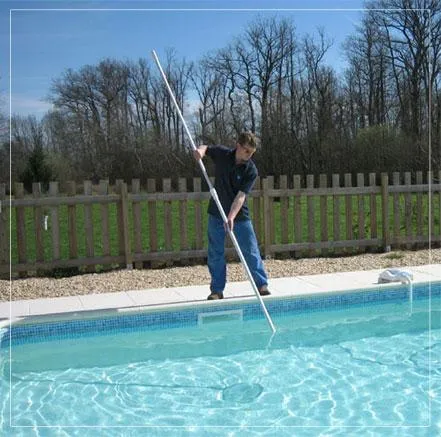September 7, 2022 by HQ Pools

Closing a pool is a long process that should be taken care of by a professional. Our pool closing services are performed by pool experts that have been doing it in Monmouth County for decades.
However, if you decide you want to do it yourself, you should do it right. Follow this step-by-step checklist for properly closing your pool in the winter so you can avoid having to deal with a maintenance headache when it’s time to open it up again in the spring!
WHAT YOU’LL NEED
Drill
Pool Skimmer
pH Increaser/Decreaser
Socket Wrenches
Pool Antifreeze
Chlorine or Salt
Pool Brush
Pool Vacuum with Pole
Algaecide
Screwdrivers
Water Test Kit
Pool Shock
STEP 1: CLEAN UP DEBRIS
We’re sure your pool is spotless because you’ve been following our pool maintenance checklist, but just make sure any debris is cleared entirely. This means skimming the surface, brushing the sides to get any scum off, and vacuuming the bottom diligently. It’s important to ensure the pool is as clean as it’s ever been to avoid any bacteria buildup while it’s closed or leaving anything that could clog the filter.
STEP 2: TEST THE WATER
Same as you’ve done all year, test and balance the pool water. Focus on the pH level, alkalinity, and calcium hardness with your pool test kit and have all the proper chemicals on hand. As a reminder, pH should be between 7.2-7.8, alkalinity between 80-100 ppm, and calcium between 180-200 ppm.
STEP 3: ADD WINTERIZING CHEMICALS
A week before you plan on closing, add phosphate remover to your pool. Phosphates promote the growth of algae, and you don’t want to open your pool to find that algae has completely taken over. In addition, you can put stain and scale chemicals to prevent the buildup of metals and minerals over the winter.
STEP 4: SHOCK THE POOL
Shock your pool to ensure it’s crystal clear and there are no contaminants remaining in the water. A 1 pound bag is usually good for 10,000 gallons, so use it accordingly.
Once the chlorine level returns to 1-3 ppm in a few days, add algaecide to the water. There are algaecide products designed specifically for pool closings
STEP 5: LOWER THE WATER LEVEL
Since pool owners in NJ live in climates that regularly get below freezing in the winter, it’s necessary to lower your water level. If you have a mesh cover, the water level should be 12-18 inches below the skimmer, and if you have a hard cover, you only need to get it 3-6 inch below the skimmer. You can do this by running your filter or using a siphon pump.
STEP 6: CLEAN AND BACKWASH
For sand filters, which are the most common type of filter, backwash it to prevent algae growth in the filter, which can cause serious problems down the road. For pool owners with a removable filter, make sure you take it out and clean it thoroughly.
STEP 7: BLOW OUT THE PUMP LINES
This is where it gets difficult for homeowners to do it themselves. Residual water in the pool pump lines can freeze over the course of a particularly harsh winter, which can damage them and cost you big down the road. In order to ensure they are as dry as possible, you should blow them out with an air compressor. If you’re unable to do so, you can purchase swimming pool antifreeze and follow the instructions on the package.
STEP 8: REMOVE ALL ACCESSORIES
Remove ladders, railings, diving boards, and wall fittings from the pool to ensure the pool cover fits properly. Clean and dry them before storing them in a spot that won’t get wet during the winter. You can also take this time to remove the skimmer basket.
STEP 9: INSTALL A COVER
There are two main types of pool covers on the market–mesh and solid vinyl. Mesh covers are more affordable, easier to put on, and don’t require maintenance–however, they are not as effective as solid vinyl covers at keeping debris out of the pool. If you’re closing the pool yourself, you are probably fine with a mesh cover. Continue to keep the area around the pool locked to prevent children or pets from falling in over the winter.
STEP 10: MONITOR YOUR POOL MONTHLY
Once a month during the winter, be sure to check on your pool water to ensure the chemical composition is still in an ideal range. If you took the proper steps, you should have to do minimal adjusting, but it’s always good to check on it to reduce the work needed when you open it up again in the spring.


